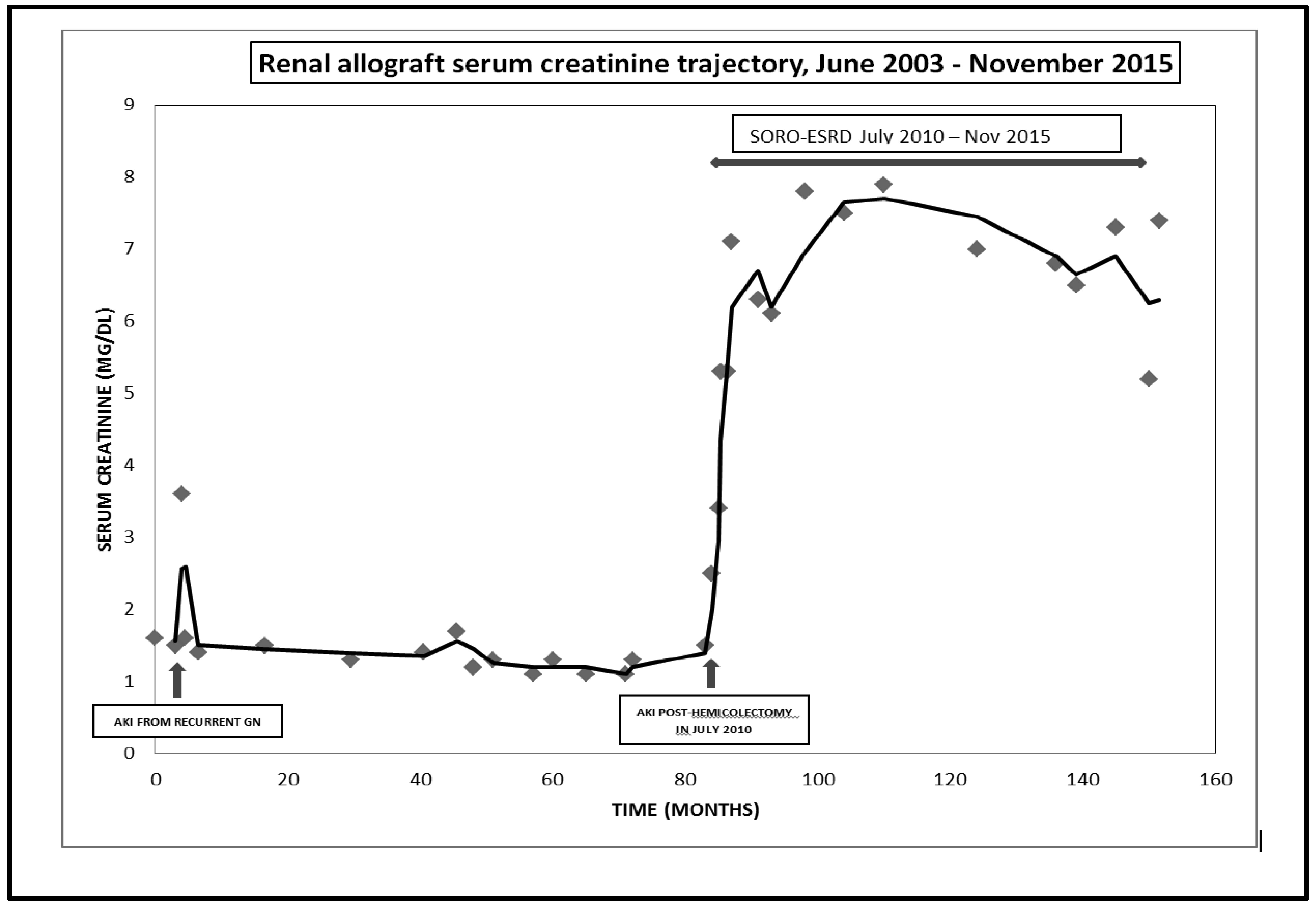A Thirteen-Year Mayo Clinic Retrospective Study of the Syndrome of Rapid Onset ESRD Among Renal Transplant Recipients, 2001-2013.
1Medicine, Mayo Clinic, Rochester, MN
2Nephrology, Mayo Clinic Health System, Eau Claire, WI
3Mental Health, North East London NHS Foundation Trust, Ilford, Essex, United Kingdom
Meeting: 2017 American Transplant Congress
Abstract number: D274
Keywords: Graft failure, Kidney transplantation, Post-operative complications, Renal failure
Session Information
Session Name: Poster Session D: Long Term Kidney Outcomes
Session Type: Poster Session
Date: Tuesday, May 2, 2017
Session Time: 6:00pm-7:00pm
 Presentation Time: 6:00pm-7:00pm
Presentation Time: 6:00pm-7:00pm
Location: Hall D1
Introduction: We described the syndrome of rapid onset ESRD (SORO-ESRD), acute yet irreversible renal failure, for the first time in the journal Renal Failure in 2010. The impact of SORO-ESRD on renal allograft survival remains speculative. Further studies are warranted.
Method: A retrospective analysis of individual patient-level serum creatinine trajectories of all 1461 ESRD patients on maintenance hemodialysis (HD) for >90 days at Mayo Clinic, Rochester, 2001-2013. SORO-ESRD diagnosis was established on the basis of previously published criteria (Figure) – the 82-yo female RTR developed AKI in July 2010 following hemicolectomy and remained on HD for over 5 years. She died in November 2015 following withdrawal from HD.  Results: 149 (10%) patients had SORO-ESRD and 13/149 (9%) SORO-ESRD patients were RTRs – 4M/9F, 12 Caucasians and one other race, mean age at first HD was 45 (18-83) years. Baseline serum creatinine before AKI was 1.4 (0.8 – 1.7) mg/dL. Initial HD access was a catheter in all 13 RTRs. Causes of AKI – acute rejection (3), post-operative states (2), tubulo-interstitial nephritis (2), unknown (2), infection/sepsis (1), contrast nephropathy (1), BKV nephropathy (1), and cardio-renal syndrome (1). Mean interval between renal transplantation and first HD following AKI was 1469 (277-4939) days. Mean days on HD was 856 (129-1630). There were 5 (38%) deaths – 3 (60%) died from cardiac arrest whereas 2 (40%) died following withdrawal from HD. Four of 13 (31%) RTRs were re-transplanted.
Results: 149 (10%) patients had SORO-ESRD and 13/149 (9%) SORO-ESRD patients were RTRs – 4M/9F, 12 Caucasians and one other race, mean age at first HD was 45 (18-83) years. Baseline serum creatinine before AKI was 1.4 (0.8 – 1.7) mg/dL. Initial HD access was a catheter in all 13 RTRs. Causes of AKI – acute rejection (3), post-operative states (2), tubulo-interstitial nephritis (2), unknown (2), infection/sepsis (1), contrast nephropathy (1), BKV nephropathy (1), and cardio-renal syndrome (1). Mean interval between renal transplantation and first HD following AKI was 1469 (277-4939) days. Mean days on HD was 856 (129-1630). There were 5 (38%) deaths – 3 (60%) died from cardiac arrest whereas 2 (40%) died following withdrawal from HD. Four of 13 (31%) RTRs were re-transplanted.
Conclusion: SORO-ESRD contributed significantly to late renal allograft loss and return to renal replacement therapy among RTRs. Mean renal allograft survival before SORO-ESRD was 1469 days or 4 years. Potentially preventable causes of AKI leading to SORO-ESRD were identified. SORO-ESRD accounted for very high (100%) dialysis catheter rates. This study calls for larger multi-center studies. There is an overarching need to evaluate ways and means to reduce renal allograft loss to SORO-ESRD.
CITATION INFORMATION: Onuigbo M, Agbasi N. A Thirteen-Year Mayo Clinic Retrospective Study of the Syndrome of Rapid Onset ESRD Among Renal Transplant Recipients, 2001-2013. Am J Transplant. 2017;17 (suppl 3).
To cite this abstract in AMA style:
Onuigbo M, Agbasi N. A Thirteen-Year Mayo Clinic Retrospective Study of the Syndrome of Rapid Onset ESRD Among Renal Transplant Recipients, 2001-2013. [abstract]. Am J Transplant. 2017; 17 (suppl 3). https://atcmeetingabstracts.com/abstract/a-thirteen-year-mayo-clinic-retrospective-study-of-the-syndrome-of-rapid-onset-esrd-among-renal-transplant-recipients-2001-2013/. Accessed December 12, 2025.« Back to 2017 American Transplant Congress
